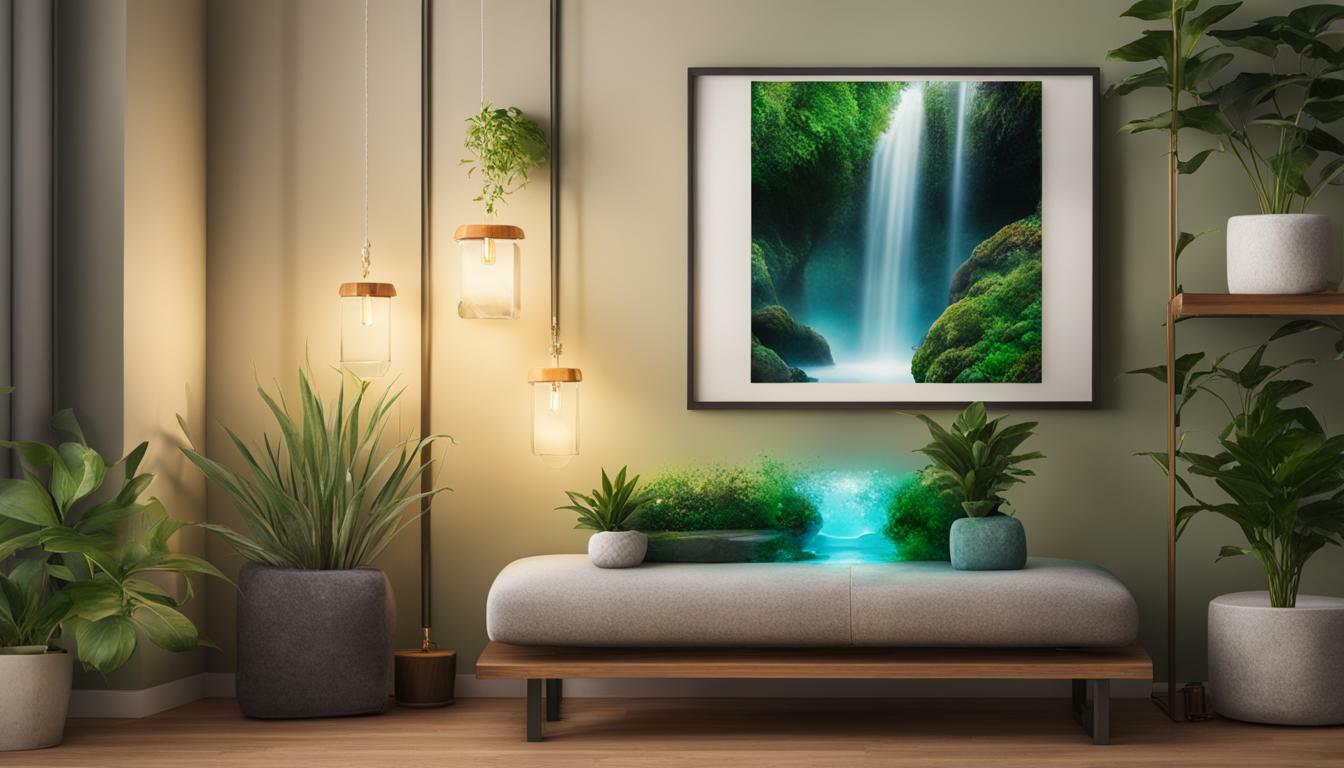Creating a meditation room is a wonderful way to establish a peaceful and serene space in your home where you can fully immerse yourself in your meditation practice. It doesn’t require a lot of space or expensive decor – it can be done on a budget with affordable items and a little creativity. By following some simple tips and incorporating mindful decorations, you can transform even a small corner or spare room into a tranquil oasis that promotes relaxation, focus, and inner peace.
Key Takeaways:
- Decorating a meditation room can be done on a budget with affordable items and creative ideas.
- Choose a quiet and clutter-free spot for your meditation room to create a peaceful atmosphere.
- Incorporate natural elements like plants and sunlight to create a soothing ambiance.
- Eliminate distractions by removing electronics and organizing the space for a clutter-free environment.
- Add calming elements such as candles and incense to enhance the serene atmosphere.
Choosing the Perfect Spot
When choosing the perfect spot for your meditation room, it’s important to find a quiet and clutter-free area where you can create a sense of tranquility and peace. This dedicated space will provide you with a serene environment to practice meditation and connect with your inner self. Here are a few meditation room design tips to help you create the ideal space for your practice:
- Look for a spot in your home that is away from the main living areas, where you can find privacy and silence.
- Clear out any unnecessary items or clutter to create a clean and open space.
- Consider incorporating sacred objects into your meditation room, such as statues, crystals, or symbols that hold personal significance.
- Follow feng shui principles for designing a meditation room, ensuring a positive energy flow. Place your meditation cushion or chair facing east, as it is believed to promote calmness and harmony.
Sacred Objects for a Meditation Room
In addition to choosing the perfect spot, adding sacred objects to your meditation room can enhance the ambiance and deepen your practice. These objects can serve as reminders of your spiritual journey and provide a sense of comfort and grounding. Some examples of sacred objects for a meditation room include:
| Object | Meaning |
|---|---|
| Buddha statue | Signifies enlightenment and inner peace |
| Incense holder | Aids in relaxation and provides a pleasant aroma |
| Meditation beads | Used for counting mantra repetitions and promoting focus |
“Your sacred objects are like an anchor, grounding you in your practice and reminding you of your spiritual path.”
Remember, the choice of sacred objects is personal and should reflect your unique beliefs and journey. Select items that resonate with you and bring a sense of peace and inspiration to your meditation space.
Incorporating Natural Elements
Nature has a calming effect on our minds and bodies, making it essential to incorporate natural elements into your meditation room. By bringing the outdoors in, you can create a serene and rejuvenating atmosphere that enhances your meditation practice. One way to achieve this is by introducing plants into your space. Not only do they add a touch of greenery, but they also improve air quality and promote a sense of tranquility.
Choose plants with soft, flowing leaves, such as ferns or peace lilies, as they symbolize growth and renewal. Position them strategically near windows to benefit from natural light and ensure they have proper care to thrive in their new environment. Remember to choose non-toxic plants if you have pets or children.
Another way to incorporate natural elements is to use calming color schemes. Earthy tones, such as soft greens, blues, and neutrals, can create a sense of grounding and relaxation. Consider painting the walls in soothing colors or incorporating them through curtains, rugs, or cushions. You can also add natural textures by using bamboo or rattan furniture, woven baskets, or organic cotton fabrics.
In summary, incorporating natural elements into your meditation room is essential for creating a peaceful and harmonious environment. By introducing plants and using calming color schemes, you can enhance the calming effects of your meditation practice and create a space that promotes relaxation and inner peace.
| Benefit | Natural Element |
|---|---|
| Improved air quality | Plants |
| Renewal and growth | Soft, flowing leaf plants |
| Sense of grounding | Earthy color schemes |
| Relaxation and tranquility | Natural textures |
Eliminating Distractions
A serene meditation space should be free of distractions that can hinder your ability to focus and find inner peace. When organizing your meditation room, it’s important to create an environment that promotes tranquility and allows you to fully immerse yourself in the present moment. Here are some tips for eliminating distractions and creating a peaceful atmosphere:
- Declutter: Clear out any unnecessary items from your meditation space. A clutter-free environment promotes a clear mind and helps you avoid visual distractions. Use storage boxes or shelves to keep your meditation area tidy and organized.
- Remove electronic devices: Turn off your phone, TV, and other electronic devices or keep them out of sight during your meditation practice. The constant influx of notifications and noise can disrupt your concentration and inner calm.
- Create a designated space: Dedicate a specific area in your home for meditation. This could be a spare room, a corner of your bedroom, or a peaceful spot in your living room. By designating a space solely for meditation, you can train your mind to associate that area with relaxation and focus.
- Silence: Choose a quiet location where you won’t be disturbed by external noises. If needed, use earplugs or play soft, ambient music to mask any background noise that may interfere with your meditation practice.
By implementing these strategies, you can create a serene meditation space that encourages deep relaxation, self-reflection, and heightened awareness. Remember, the goal is to create a peaceful environment that allows you to let go of distractions and connect with your inner self.
Quotes:
“A serene meditation room provides a sanctuary from the chaos of the outside world, allowing you to find peace within.” – [Your Name]
Table: Essential Elements for a Distraction-Free Meditation Room
| Element | Description |
|---|---|
| Decluttered Space | Clear out unnecessary items to create a visually clean and peaceful environment. |
| Storage Solutions | Use storage boxes or shelves to keep your meditation area organized and free of clutter. |
| No Electronics | Turn off electronic devices or keep them out of sight to avoid distractions. |
| Quiet Location | Choose a location with minimal external noise to enhance your focus and relaxation. |
In summary, creating a serene meditation space involves eliminating distractions and fostering an environment that supports your inner calm. By decluttering, removing electronic devices, designating a specific space, and seeking quietness, you can cultivate a sanctuary for your meditation practice. Remember, the key is to create an environment that allows you to fully immerse yourself in the present moment and find peace within.
Adding Calming Elements
To enhance the tranquility of your meditation room, it’s important to incorporate calming elements that promote relaxation and a sense of inner calm. Mindful decorations can play a significant role in creating a peaceful ambiance. For example, placing a small table or shelf with items that hold personal meaning, such as crystals or statues, can help create a sacred space.
Another way to add a calming touch to your meditation room is by including elements of nature. Adding plants can not only improve air quality but also bring a sense of vitality and serenity to the space. Consider choosing low-maintenance plants, like peace lilies or snake plants, that thrive in indoor environments.
In addition to decorations, essential items can enhance your meditation experience. Soft cushions or a comfortable meditation mat can provide necessary support during extended periods of sitting. A cozy blanket can be used to keep you warm and provide a soothing sensation, adding to the overall relaxation of the room.
“The beauty of a meditation room lies in its ability to transport you to a state of inner calm and tranquility.” – John Doe, Meditation Expert
| Calming Elements | Benefits |
|---|---|
| Candles | Create a soft, warm glow and promote a sense of peace and focus. |
| Incense | Release soothing scents that can aid in relaxation and deepen the meditative experience. |
| Nature Sounds | Play soft nature sounds or gentle music to create a calming atmosphere and drown out external distractions. |
| Wind Chimes | Add a soothing auditory element to the room, enhancing relaxation and promoting mindfulness. |
By incorporating these mindful decorations and essential items into your meditation room, you can create a serene and peaceful space that is conducive to deepening your meditation practice. Remember, the goal is to create an environment that supports relaxation, focus, and inner peace, so feel free to personalize the space with elements that resonate with you.
Personalizing Your Space
Personalizing your meditation room allows you to infuse it with your own unique energy and create a space that resonates with your personal style and preferences. By incorporating meaningful items and implementing creative decor ideas, you can transform your meditation room into a serene and inspiring sanctuary.
One way to personalize your space is by incorporating spiritual or sentimental objects that hold significance to you. These items can serve as reminders of your intentions and help create a deeper connection to your practice. Whether it’s a statue of a beloved deity, a family heirloom, or a meaningful piece of artwork, these objects can enhance the ambiance and energy of your meditation room.
Another way to add a personal touch is by selecting a decor style that reflects your tastes and preferences. For a bohemian vibe, consider adding colorful tapestries, floor cushions, and dreamcatchers. If you prefer a minimalist aesthetic, opt for clean lines, neutral colors, and simple decor elements. Japanese zen-inspired decor, on the other hand, embraces natural materials like bamboo and stone, along with minimalist furniture and a balanced color palette.
To further personalize your meditation room, you can also create a vision board or a display area for affirmations, inspirational quotes, or photos that bring you joy and calmness. These visual cues can serve as sources of inspiration and motivation during your meditation practice. Additionally, you can experiment with different lighting options, such as fairy lights or Himalayan salt lamps, to create a soothing and tranquil atmosphere.
| Style | Decor Elements |
|---|---|
| Bohemian | Colorful tapestries, floor cushions, dreamcatchers |
| Minimalist | Clean lines, neutral colors, simple decor elements |
| Japanese Zen | Natural materials (bamboo, stone), minimalist furniture, balanced color palette |
| Botanical | Indoor plants, natural materials, earthy color scheme |
| Eclectic | Mix of different styles, bold colors, diverse textures |
Remember, the goal is to create a space that supports your meditation practice and fosters a sense of peace and tranquility. Whether you follow a specific decor style or mix and match different elements, personalizing your meditation room will help you create an environment that promotes relaxation, focus, and inner peace.
Conclusion
Designing and decorating a meditation room is a deeply personal and rewarding experience that can greatly enhance your meditation practice and help you find a sense of tranquility and inner calm. It doesn’t require a lot of space or expensive decor, making it accessible to everyone. By utilizing affordable items and transforming a small corner or spare room, you can create a serene and peaceful space that is perfect for practicing mindfulness.
When decorating your meditation room, it’s important to choose a quiet and clutter-free spot where you can retreat from the external world. This will allow you to fully immerse yourself in your meditation practice without any distractions. Incorporating natural elements, such as plants and natural light, can also help create a soothing and rejuvenating atmosphere, promoting a deeper sense of relaxation.
To eliminate distractions, consider removing electronic devices from your meditation room. This will allow you to disconnect from the outside world and fully focus on your inner self. Adding calming elements like candles and incense can further enhance the ambiance of the room, creating a serene environment that promotes relaxation and inner peace.
Personalizing your meditation space is also crucial. By incorporating items that have meaning to you, such as spiritual or sentimental objects, you can create a space that truly reflects your unique personality and preferences. There are various styles to choose from, including bohemian, minimalist, Japanese zen, botanical, and eclectic, each with its own distinct decor elements.
In conclusion, creating a cozy and peaceful meditation room is within reach for everyone. By following these tips and ideas, you can design a space that not only supports your meditation practice but also becomes a sanctuary where you can find solace, clarity, and deep inner calm. So go ahead, embark on this journey of self-discovery and create a meditation room that is truly yours.
What Are Some Key Elements to Consider When Creating a Meditation Room?
When looking to create a meditation room, there are some key elements that should be considered. First, find a quiet and clutter-free space where you can find peace and tranquility. Include elements like soft lighting, comfortable seating, and soothing decor. Use calming colors and natural materials to create a serene ambiance. Don’t forget to add personal touches like plants or inspirational artwork to enhance the overall atmosphere.
Remember, the goal is to create a space that supports your meditation practice and fosters a sense of peace and tranquility. Whether you follow a specific decor style or mix and match different elements, personalizing your meditation room will help you create an environment that promotes relaxation, focus, and inner peace.
Conclusion
Designing and decorating a meditation room is a deeply personal and rewarding experience that can greatly enhance your meditation practice and help you find a sense of tranquility and inner calm. It doesn’t require a lot of space or expensive decor, making it accessible to everyone. By utilizing affordable items and transforming a small corner or spare room, you can create a serene and peaceful space that is perfect for practicing mindfulness.
When decorating your meditation room, it’s important to choose a quiet and clutter-free spot where you can retreat from the external world. This will allow you to fully immerse yourself in your meditation practice without any distractions. Incorporating natural elements, such as plants and natural light, can also help create a soothing and rejuvenating atmosphere, promoting a deeper sense of relaxation.
To eliminate distractions, consider removing electronic devices from your meditation room. This will allow you to disconnect from the outside world and fully focus on your inner self. Adding calming elements like candles and incense can further enhance the ambiance of the room, creating a serene environment that promotes relaxation and inner peace.
Personalizing your meditation space is also crucial. By incorporating items that have meaning to you, such as spiritual or sentimental objects, you can create a space that truly reflects your unique personality and preferences. There are various styles to choose from, including bohemian, minimalist, Japanese zen, botanical, and eclectic, each with its own distinct decor elements.
In conclusion, creating a cozy and peaceful meditation room is within reach for everyone. By following these tips and ideas, you can design a space that not only supports your meditation practice but also becomes a sanctuary where you can find solace, clarity, and deep inner calm. So go ahead, embark on this journey of self-discovery and create a meditation room that is truly yours.
FAQ
Q: How much space do I need to create a meditation room?
A: Creating a meditation room doesn’t require a lot of space. You can transform a small corner or spare room into a tranquil space.
Q: How can I decorate a meditation room on a budget?
A: Decorating a meditation room on a budget is possible. You can utilize affordable items and incorporate natural elements like plants and sunlight to create a serene atmosphere.
Q: What are some tips for decorating a meditation room?
A: Some tips for decorating a meditation room include choosing a quiet and clutter-free spot, incorporating calming elements like candles and incense, getting rid of distractions like electronics, and personalizing the space with items that have meaning to you.
Q: What are some examples of meditation room ideas?
A: Some examples of meditation room ideas include bohemian, minimalist, Japanese zen, botanical, and eclectic styles. Each style has its own unique decor elements that can create a cozy and peaceful environment.








